Winsor McCay
| Winsor McCay | |
|---|---|
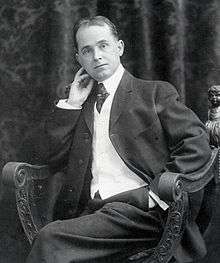 Winsor McCay in 1906 | |
| Born |
Zenas Winsor McKay c. 1867–1871 or September 26, 1869 Spring Lake, Michigan, United States; or Canada (disputed) |
| Died |
July 26, 1934[1] Brooklyn, New York, United States[1] |
| Cause of death | Cerebral embolism |
| Resting place |
Cemetery of the Evergreens, Brooklyn, New York[2] 40°41′2.0″N 73°54′4.3″W / 40.683889°N 73.901194°W |
| Occupation |
|
| Notable work | |
| Spouse(s) | Maude Leonore McCay (m. 1891–1934) |
| Children |
|
| Parent(s) |
|
| Signature | |
 | |
Zenas Winsor McCay (c. 1867–71 or September 26, 1869 – July 26, 1934) was an American cartoonist and animator. He is best known for the comic strip Little Nemo (1905–14; 1924–26) and the animated film Gertie the Dinosaur (1914). For contractual reasons, he worked under the pen name Silas on the comic strip Dream of the Rarebit Fiend.
From a young age, McCay was a quick, prolific, and technically dextrous artist. He started his professional career making posters and performing for dime museums, and began illustrating newspapers and magazines in 1898. He joined the New York Herald in 1903, where he created popular comic strips such as Little Sammy Sneeze and Dream of the Rarebit Fiend. In 1905, his signature strip Little Nemo in Slumberland debuted, a fantasy strip in an Art Nouveau style, about a young boy and his adventurous dreams. The strip demonstrated McCay's strong graphic sense and mastery of color and linear perspective. McCay experimented with the formal elements of the comic strip page, arranging and sizing panels to increase impact and enhance the narrative. McCay also produced numerous detailed editorial cartoons and was a popular performer of chalk talks on the vaudeville circuit.
McCay was an early animation pioneer; between 1911 and 1921 he self-financed and animated ten films, some of which survive only as fragments. The first three served in his vaudeville act; Gertie the Dinosaur was an interactive routine in which McCay appeared to give orders to a trained dinosaur. McCay and his assistants worked for twenty-two months on his most ambitious film, The Sinking of the Lusitania (1918), a patriotic recreation of the German torpedoing in 1915 of the RMS Lusitania. Lusitania did not enjoy as much commercial success as the earlier films, and McCay's later movies attracted little attention. His animation, vaudeville, and comic strip work was gradually curtailed as newspaper magnate William Randolph Hearst, his employer since 1911, expected McCay to devote his energies to editorial illustrations.
In his drawing, McCay made bold, prodigious use of linear perspective, particularly in detailed architecture and cityscapes. He textured his editorial cartoons with copious fine hatching, and made color a central element in Little Nemo. His comic strip work has influenced generations of cartoonists and illustrators. The technical level of McCay's animation—its naturalism, smoothness, and scale—was unmatched until Walt Disney's feature films arrived in the 1930s. He pioneered inbetweening, the use of registration marks, cycling, and other animation techniques that were to become standard.
Personal history
Family history
McCay's paternal grandparents, farmers Donald and Christiana McKay, immigrated from Scotland to Upper Canada[lower-alpha 1] in the mid-1830s. McCay's father, Robert McKay (1840 – March 21, 1915) was born in Woodstock, Upper Canada, the third of six children. McCay's maternal grandparents, Peter and Mary Murray, were also Scottish immigrants, and settled as farmers in East Zorra in Upper Canada. Their daughter Janet was the third of nine children.[3]
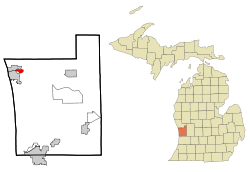
Robert was a member of King Solomon's No. 43 Masonic Lodge in Woodstock.[4] In 1862, Robert first traveled to the U.S.[5] Robert and the twenty-five-year-old Janet married on January 8, 1866, at Woodstock's Methodist Episcopal Church. The couple moved across the Canada–US border later in the year and settled in Spring Lake, Michigan, on the eastern coast of Lake Michigan.[3] Robert was employed by American entrepreneur Zenas G. Winsor (1814–1890), with whom he had made contact in Canada.[5]
Records of McCay's birth are not extant. He stated in an interview in 1910 that he was born in 1869, and this is the year listed on his grave marker. Late in life, he told friends he was born September 26, 1871, in Spring Lake, and they published this information in a magazine.[5] Michigan census records from 1870 and 1880 list a Zenas W. McKay, who was born in Canada in 1867.[6] No Canadian birth record has been found, and a fire in Spring Lake in May 1893 could have destroyed any American birth record he may have had.[5] His obituary in the New York Herald Tribune stated, "not even Mr. McCay knew his exact age".[7]
The McCays had two more children: Arthur in 1868, and Mae in 1876. Both were born in Michigan. Robert worked as a teamster under Winsor, and by May 1870 had saved enough money to buy a parcel of land. From 1879 to 1881 he worked as a retail grocer.[5] In 1885 he moved the family to Stanton, Michigan, and expanded his land holdings; he was successful in real estate with his brother Hugh, who moved from Canada in 1887.[8]
By 1905, Robert was also a notary public. He had settled in Edmore, Michigan, and by this point had changed the spelling of his surname from "McKay" to "McCay".[8] His son related this story about the change:
"Three Scotsmen of the clan McKay were looking for a fourth member to fight four members of the Irish clan Magee ... 'I'm not one of you,' my father pointed out. 'You see, I'm one of the clan M-c-C-A-Y.' And that is how I got both my name and my sense of humor."— Winsor McCay[8]
Early life
"I just couldn't stop drawing anything and everything."
Winsor McCay[8]
McCay came to be known by his middle name, Winsor. His drawing skills emerged early. According to a story told within the family, McCay made his first drawing in the aftermath of one of the many fires that hit Spring Lake: he picked up a nail and etched the scene of the fire in the frost of a windowpane. Drawing became obsessive for him;[8] he drew anything he saw, and the level of detail and accuracy in his drawing was noted at a young age. He was able to draw accurately from memory even things he had never before drawn—what McCay called "memory sketching". His father thought little of his son's artistic talents, though,[9] and had him sent to Cleary Business College in Ypsilanti, Michigan.[10] McCay rarely attended classes. He bragged about how he would catch the train to Detroit to show off his drawing skills at the Wonderland and Eden Musee dime museum. He drew portraits there for 25¢ apiece, of which he kept half.[11]
McCay thrived on the attention he received, and his talents soon drew wider attention. John Goodison, a geography and drawing professor at Michigan state Normal School, offered to teach art to McCay privately, and McCay eagerly accepted. The lessons were practical and focused on using observation to learn to draw in geometrical perspective.[12] Goodison, a former glass stainer, influenced McCay's use of color. McCay learned how to draw quickly using drills on a blackboard, and gained an appreciation for master artists of the past.[13]
Early career (1889–1903)
McCay spent two years in Chicago[14] after making his way there sometime in 1889 with his friend Mort Touvers.[15] He traded art techniques there with painter Jules Guérin, whom he met at a boarding house in which he lodged, and did artwork for posters and pamphlets at the National Printing and Engraving Company.[16]
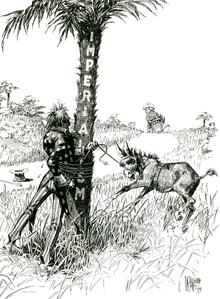
In 1891, McCay moved to Cincinnati, where he did more dime museum work[14] while living in a boarding house near his workplace. He spent nine years making posters and other advertisements for the Kohl & Middleton Dime Museum,[lower-alpha 2][14] and later Heck and Avery's Family Theater (1896), Avery's New Dime Museum (1898), and Will S. Heck's Wonder World and Theater (1899)[17] on Vine Street. At the museum in 1896, a demonstration of Thomas Edison's Vitascope was given, which was likely McCay's first exposure to the young medium of film.[18] He also did work during this time for Ph. Morton's printing and lithography company. McCay's ability to draw quickly with great accuracy drew crowds when he painted advertisements in public.[19]
His first year at Kohl & Middleton, McCay was smitten when Maude Leonore Dufour walked into the dime museum with her sister while he was painting. He rushed to his studio to change into a custom-tailored suit, returned, and introduced himself to the fourteen-year-old Maude.[20] Soon they eloped in Covington, Kentucky.[7]
McCay began working on the side for the Cincinnati Commercial Tribune, where he learned to draw with a dip pen under the tutelage of Commercial Tribune art room manager Joseph Alexander. In 1898, he accepted a full-time position there.[21] His many illustrations for the paper displayed his bold use of perspective and mastery of hatchwork. Soon after, he began freelancing for the humor magazine Life as well.[22]
In 1900, McCay accepted a position with a higher salary at The Cincinnati Enquirer. There, he produced a prolific number of drawings, did some reporting, and became head of the art department. In his drawings, he began using line thickness to indicate depth, and used thick lines to surround his characters in an Art Nouveau-inspired style that became a trademark of his work.[23]
Comic strips (1903–1911)
_panels_11_to_15.jpg)
From January until November 1903, McCay drew an ongoing proto-comic strip for the Enquirer based on poems written by George Randolph Chester called A Tale of the Jungle Imps by Felix Fiddle.[24] Before the last two instalments appeared in print, McCay had moved to New York City to work for James Gordon Bennett, Jr.'s New York Herald,[25] at first doing illustrations and editorial cartoons.[26] He worked alongside comic strip pioneer Richard F. Outcault, who was doing the Buster Brown strip at the Herald. A rivalry built up between the two cartoonists which resulted in Outcault leaving the Herald to return to his previous employer, William Randolph Hearst at The New York Journal.[27]
McCay's first continuing comic strip, Mr. Goodenough, debuted in the Evening Telegram on January 21, 1904. The formula for the strip was that a sedentary millionaire would seek ways to become more active, with embarrassing results. Sister's Little Sister's Beau, McCay's first strip with a child protagonist, lasted one instalment that April, and his first color strip, Phurious Phinish of Phoolish Philipe's Phunny Phrolics, appeared in the Herald's Sunday supplement that May.[28]
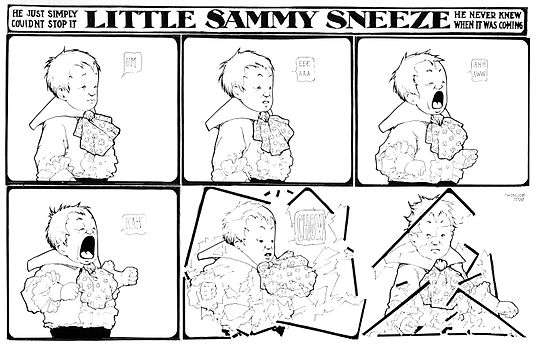
McCay's first popular comic strip was Little Sammy Sneeze. The strip starred a young boy whose sneeze would build panel by panel until it was released, with explosively disastrous results, for which he was usually punished or chased away by those affected. The strip debuted in July 1904 and ran until December 1906.[28]
McCay's longest-running strip, Dream of the Rarebit Fiend, first appeared in the Evening Telegram in September 1904. The strip was aimed at an adult audience,[29] and had no recurring characters. The characters that appeared in the strip would have fantastic, sometimes terrifying dreams, only to wake up in the last panel, cursing the Welsh rarebit they had eaten the night before, which they blamed for bringing on the dream.[30] Rarebit Fiend was so popular that a book collection appeared in 1905 from publisher Frederick A. Stokes. It was adapted to film by Edwin S. Porter, and plans were made for a "comic opera or musical extravaganza" for stage that failed to materialize.[29] McCay signed the Rarebit Fiend strips with the pen name "Silas", as his contract required that he not use his real name for his Evening Telegram work.[31]
The McCays had been living in Manhattan, close to the Herald offices; before 1905 they moved to Sheepshead Bay in Brooklyn, New York, a seaside resort on Long Island. It was an hour commute from the Herald offices, but they believed it to be a better place to raise children. They lived at a number of addresses before settling into a three-story house at 1901 Voorhies Avenue, where McCay resided for the rest of his life.[32] As his reputation grew, his employers allowed him to work from his home studio more often.[33]
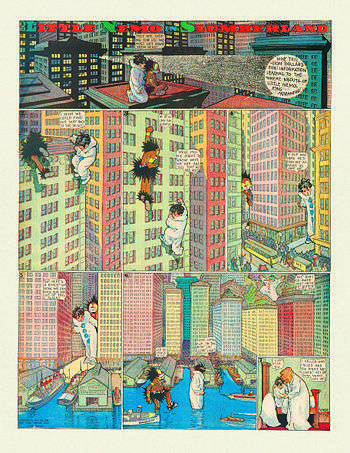
September 9, 1907
While still turning out illustrations and editorial cartoons daily,[34] McCay began three more continuing strips in 1905. In January, he began The Story of Hungry Henrietta, in which the child protagonist visibly ages week by week, and eats compulsively in lieu of the love she craves from her parents.[35] A Pilgrim's Progress by Mister Bunion was another "Silas" strip for the Evening Telegram, which ran from June 1905 until December 1910. Mr. Bunion spent each strip unsuccessfully scheming to rid himself of his suitcase, labeled "Dull Care".[36]
McCay got "an idea from the Rarebit Fiend to please the little folk",[34] and in October 1905 the full-page Sunday strip Little Nemo in Slumberland debuted in the Herald.[37] Considered McCay's masterpiece,[38] its child protagonist had fabulous dreams, interrupted each week with his awakening in the final panel.[39] Nemo's appearance was based on McCay's son Robert.[40] McCay experimented with formal aspects of the comics page: he made inventive use of timing and pacing, the size and shape of panels, perspective, and architectural and other details.[39] The Herald was considered to have the highest quality color printing of any newspaper at the time; its printing staff used the Ben Day process for color,[36] and McCay annotated the Nemo pages with precise color schemes for the printers.[41]
Impresario F. F. Proctor approached McCay in April 1906 to perform chalk talks for the vaudeville circuit.[42] For $500 per week he was to draw twenty-five sketches in fifteen minutes before live audiences, as a pit band played a piece called "Dream of the Rarebit Fiend".[43] In his The Seven Ages of Man routine, he drew two faces and progressively aged them.[44] His first performance was on June 11, 1906,[43] in a show that also featured entertainer W. C. Fields.[43] It was a success, and McCay toured with the show throughout 1907,[45] while managing to complete his comic strip and illustration work on time, often working in hotel rooms or backstage.[46]
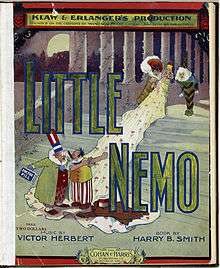
As early as 1905, several abortive attempts were made to produce a stage version of Little Nemo. In mid-1907, Marcus Klaw and A. L. Erlanger announced they would put on an extravagant Little Nemo show for an unprecedented $100,000, with a score by Victor Herbert[47] and lyrics by Harry B. Smith.[47] It starred midget Gabriel Weigel as Nemo, Joseph Cawthorn as Dr. Pill, and Billy B. Van as Flip.[48] Reviews were positive; it played to sold-out houses in New York and toured for two seasons.[49] McCay brought his vaudeville act to each city where Little Nemo played. When the Keith circuit[lower-alpha 3] refused McCay to perform in Boston without a new act, McCay switched to the William Morris circuit, with a $100-a-week raise.[50] In several cities, McCay brought his son, who as publicity sat on a small throne dressed as Nemo.[51]
As part of an improvised story, Cawthorn introduced a mythical creature he called a "Whiffenpoof". The word caught on with the public, and became the name of a hit song and a singing group.[48] Despite the show's success, it failed to make back its investment due to its enormous expenses[50] and came to an end in December 1910.[51]
McCay displayed his social awareness in the last strip he created for the Herald, Poor Jake. Its title character was a silent laborer who worked thanklessly for a Colonel and Mrs. Stall, who exploit him. The strip ran from 1909 until spring 1911.[52]
McCay was approached in early 1910 to bring his vaudeville show to Europe. McCay requested the Herald's permission, but the plans never materialized. His show stayed within the eastern U.S. until he ceased performing in 1917. Biographer John Canemaker assumed McCay's request to tour Europe was turned down, and that the refusal added to McCay's growing frustration with the Herald. A distrust of big business became pronounced in McCay's work around this time, including a story arc in Little Nemo in which the characters visit a Mars oppressed by a greedy business magnate.[53]
Animation (1911–1921)
McCay said he was most proud of his animation work.[54] He completed ten animated films between 1911 and 1921,[55] and three more were planned.[56]
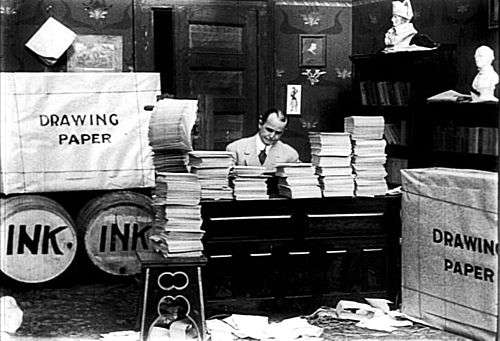
Inspired by the flip books his son brought home,[57] McCay "came to see the possibility of making moving pictures"[58] of his cartoons. He claimed to be "the first man in the world to make animated cartoons", though he was preceded by others such as James Stuart Blackton and Émile Cohl.[58] McCay made four thousand drawings on rice paper for his first animated short, which starred his Little Nemo characters. They were shot at Vitagraph Studios under Blackton's supervision. Live-action sequences were added to the beginning and end of the film, in which McCay bets his newspaper colleagues that in one month he can make four thousand drawings that move. Among those featured in these sequences were cartoonist George McManus and actor John Bunny.[59] Little Nemo debuted in movie theatres on April 8, 1911, and four days later McCay began using it as part of his vaudeville act.[59] Its good reception motivated him to hand-color each of the frames of the originally black-and-white animation.[60]
_Mosquito_panel_6.png)
McCay had become frustrated with the Herald, partly over money issues[61] and partly because he perceived a lack of freedom.[54] He accepted a higher-paying offer in spring 1911 from Hearst at the New York American and took Little Nemo's characters with him. The Herald held the strip's copyright,[61] but McCay won a lawsuit that allowed him to continue using the characters,[62] which he did under the title In the Land of Wonderful Dreams. The Herald was unsuccessful in finding another cartoonist to continue the original strip.[61]
McCay began work that May on his next animated film, How a Mosquito Operates,[61] based on a Rarebit Fiend episode from June 5, 1909,[63] in which a man in bed tries in vain to defend himself from a giant mosquito, which drinks itself so full that it explodes.[64] The animation is naturalistic—rather than expanding like a balloon, with each sip of blood the mosquito's abdomen swells according to its body structure.[65] The film was completed in January 1912,[61] and McCay toured with it that spring and summer.[63]

Gertie the Dinosaur debuted in February 1914 as part of McCay's vaudeville act. McCay introduced Gertie as "the only dinosaur in captivity",[66] and commanded the animated beast with a whip.[66] Gertie seemed to obey McCay, bowing to the audience, and eating a tree and a boulder, though she had a will of her own and sometimes rebelled. When McCay admonished her, she cried. McCay consoled her by throwing her an apple—in reality pocketing the cardboard prop apple as a cartoon one simultaneously appeared on screen.[67] In the finale, McCay walked offstage, reappeared in animated form in the film, and had Gertie carry him away.[68] Producer William Fox's Box Office Attractions obtained distribution rights to a modified version of Gertie that could be played in regular movie theaters. This version was prefaced with a live-action sequence and replaced the interactive portions with intertitles.[69]
Gertie was McCay's first piece of animation with detailed backgrounds.[62] McCay drew the foreground characters, while art student neighbor John A. Fitzsimmons traced the backgrounds.[70] McCay pioneered the "McCay Split System" of inbetweening, in which major poses or positions were drawn first, and the intervening frames drawn after. This relieved tedium and improved the timing of the film's actions. McCay refused to patent his system,[71] and was sued in 1914 by animator John Randolph Bray,[72] who took advantage of McCay's lapse by patenting many of McCay's techniques, including the use of registration marks, tracing paper, the Mutoscope action viewer, and the cycling of drawings to create repetitive action.[73] The lawsuit was unsuccessful, and there is evidence that McCay may have countersued — he thereafter received royalty payments from Bray for licensing the techniques.[74]
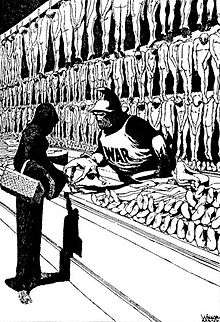
"His Best Customer", 1917
Hearst was disappointed with the quality of McCay's newspaper work. Infuriated that he couldn't reach McCay during a vaudeville performance, Hearst pulled from his papers advertising for the theatre where McCay performed.[75] Editor Arthur Brisbane told him that he was "a serious artist, not a comic cartoonist",[76] and that he was to give up his comic strip work to focus on editorial illustrations.[76] Hearst pressured McCay's agents to reduce the number of his vaudeville appearances, and he was induced to sign a contract with Hearst that limited his vaudeville appearances to greater New York,[69] with occasional exceptions.[77] In February 1917, Hearst had McCay give up entirely on vaudeville and all other paid work outside the Hearst empire, though he was occasionally granted permission for particular shows. Hearst increased McCay's salary to cover the loss of income.[78]
McCay was expected to report daily to the American building, where he shared a ninth-floor office with humorist Arthur "Bugs" Baer and sports cartoonist Joe McGurk.[79] There, he illustrated editorials by Arthur Brisbane, who often sent back McCay's drawings with instructions for changes.[80] The quality of his drawings varied depending on his interest in the subject of the assignment,[81] whether or not he agreed with the sentiments portrayed,[82] and on events in his personal life.[81] For example, in March 1914 he was subjected to a blackmail plot by a Mrs. Lambkin, who was seeking a divorce from her husband. Lambkin alleged that McCay's wife Maude was seeing her husband. With McCay's level of fame, such a story would likely be in the papers, and Mrs. Lambkin and her husband told McCay that she would keep it secret for $1,000. McCay did not believe the allegations, and gave testimony at the Lambkins' divorce trial. The blackmail failed, and the divorce was not granted.[83]
Hearst animation studio International Film Service began in December 1915, and brought Hearst cartoonists to the screen. McCay was initially listed as one of them, but the studio never produced anything either by his hands or featuring his creations. McCay derived satisfaction from doing the work himself. Begun in 1916, The Sinking of the Lusitania was his follow-up to Gertie. The film was not a fantasy but a detailed, realistic recreation of the 1915 German torpedoing of the RMS Lusitania. The event counted 128 Americans among its 1,198 dead, and was a factor leading to the American entry into World War I.[84]
McCay's daughter Marion married military man Raymond T. Moniz, eighteen years her senior, on October 13, 1917.[85] She gave birth to McCay's first grandchild, Ray Winsor Moniz, on July 16, 1918.[85] Moniz and McCay's son Robert were called up for service when the U.S. entered World War I.[85]
.jpg)
McCay's self-financed Lusitania took nearly two years to complete.[86] With the assistance of John Fitzsimmons and Cincinnati cartoonist William Apthorp "Ap" Adams, McCay spent his off hours drawing the film on sheets of cellulose acetate (or "cels") with white and black India ink at McCay's home.[87] It was the first film McCay made using cels,[86] a technology animator Earl Hurd had patented in 1914; it saved work by allowing dynamic drawings to be made on one or more layers, which could be laid over a static background layer, relieving animators of the tedium of retracing static images onto drawing after drawing.[88] McCay had the cels photographed at the Vitagraph studios.[87] The film was naturalistically animated, and made use of dramatic camera angles that would have been impossible in a live-action film.[89]
Jewel Productions released the film on July 20, 1918. Advertising touted it as "the picture that will never have a competitor";[86] the film itself called McCay "the originator and inventor of Animated Cartoons"[86] and drew attention to the fact that it took 25,000 drawings to complete.[90] The Sinking of the Lusitania did not greatly return on McCay's investment—after a few years' run in theaters, it netted $80,000.[86]
McCay continued to produce animated films using cels. By 1921, he had completed six, though three were likely never shown commercially to audiences and have survived only in fragments: The Centaurs, Flip's Circus, and Gertie on Tour. In 1921, he released three films based on Dream of the Rarebit Fiend: Bug Vaudeville, in which insects and other creepy-crawlies perform on stage; The Pet, in which a creature with a bottomless appetite grows enormously and terrorizes the city in a way reminiscent of King Kong; and The Flying House, in which a man attaches wings to his house to flee from debt. McCay's son Robert is credited with the animation on this last film, but Canemaker notes it is highly unlikely that a first-time animator could have produced such an accomplished piece of animation.[91]
Later career (1921–1934)
After 1921, McCay was made to give up on animation when Hearst learned he devoted more of his time to animation than to his newspaper illustrations.[92] Unexecuted ideas McCay had for animation projects included a collaboration with Jungle Imps author George Randolph Chester, a musical film called The Barnyard Band,[93] and a film about the Americans' role in World War I.[94]

McCay's son Robert married Theresa "Tedda" Munchausen on April 9, 1921. McCay bought them a nearby house as a wedding gift. The couple gave McCay two more grandchildren: Janet (named after McCay's mother) in 1922, and Robert in 1928.[95] Robert suffered shell shock during World War I,[96] and following the war had difficulty drawing. McCay tried to boost his son's confidence by finding him cartooning work, and some of the elder McCay's editorial cartoons were signed "Robert Winsor McCay, Jr."[97]
In 1922, McCay resumed doing vaudeville shows for the Keith circuit.[98] He had a cameo in a newspaper office scene in the boxing film The Great White Way in early 1924.[97]
McCay left Hearst upon the expiration of his contract in May 1924, bitter over not having received a promised $5,000 bonus.[99] He returned to the Herald Tribune, and brought back Little Nemo beginning that August.[100] The new strip displayed the virtuoso technique of the old, but the panels were laid out in an unvarying grid. Nemo took a more passive role in the stories,[97] and there was no continuity.[101] The strip came to an end in December 1926,[100] as it was not popular with readers. Hearst executives had been trying to convince McCay to return to the American, and succeeded in 1927. While McCay was gone, his place had been filled by Mel Cummin, who was let go after McCay's return.[101] Due to the lack of the 1920s Nemo's success, the Herald Tribune signed over all copyrights to the strip to McCay for one dollar.[102]
In 1927, McCay attended a dinner in his honor in New York. After a considerable amount of drinking, McCay was introduced by animator Max Fleischer. McCay gave the gathered group of animators some technical advice, but when he felt the audience was not giving him attention, he berated his audience, saying, "Animation is an art. That is how I conceived it. But as I see, what you fellows have done with it, is making it into a trade. Not an art, but a trade. Bad Luck!"[103] That September he appeared on the radio at WNAC, and on November 2 he was interviewed by Frank Craven for The Evening Journal's Woman's Hour. During both appearances he complained about the state of contemporary animation.[104]
An executive of the American Tobacco Company approached McCay in 1929 to do an advertising campaign for a financial "sum in excess of his annual salary". Brisbane refused, noting that McCay's contract didn't allow outside work. When the executive stormed into Brisbane's office threatening to pull American Tobacco's advertising dollars from the American, Brisbane provided a written release for the work.[105]
In 1932, McCay found himself in what he recalled as "the wildest ride" in his life when Hearst's son "Young Bill" drove him at 85 miles per hour (137 km/h) to the scene of the kidnapping of the Lindbergh baby. They arrived there two hours after the crime was first reported to police, and were able to interview the gathered police before the grounds were closed off to the public. McCay sketched the scene, the staff, and the ladders the kidnappers used, which he was allowed to see up close.[106]
McCay enjoyed robust health most of his life. On July 26, 1934, he complained to his wife of a severe headache. To his horror, he found his right arm—his drawing arm—was paralyzed. He lost consciousness and was pronounced dead later that afternoon, with his wife, children, and son-in-law by his side.[107] He had died of a cerebral embolism,[108] and was buried at the Cemetery of the Evergreens in Brooklyn[2] in a family plot. He had a Masonic funeral in his home, attended by his newspaper colleagues, Hearst and his son, and the Society of Illustrators, among others.[109]
Brisbane hired back Mel Cummin to replace McCay.[109] Due to his lavish lifestyle, McCay left a smaller fortune than those around him had expected. By the early 1940s, Maude had used up her inheritance and sold the house on Voorhies Avenue. When she died of a heart attack on March 2, 1949, she was living with her daughter and son-in-law.[109] Son Robert was also careless with his inheritance, and less successful in art than his father. He worked for a short time at the Hearst papers, and tried unsuccessfully to get a job at the Disney studios, before finding a career as illustrator for Training Aids/Special Services at Fort Ord.[110]
Personal life
Self-conscious and introverted in private, McCay was nevertheless a charismatic showman and self-promoter,[111] and maintained several lifelong friendships.[18] McCay was a light but frequent drinker; he drank for camaraderie rather than for a love of drinking.[112] To his wife's chagrin, McCay was a smoker of cigars and cigarettes.[113] He was self-taught at the piano,[113] and was an avid reader of poetry, plays and novels; he admired W. B. Yeats, knew the works of Percy Bysshe Shelley and John Keats, and could quote the Bible and Shakespeare.[112]
McCay stood barely five feet (150 cm) tall,[114] and felt dominated by his wife, who was nearly as tall as he was.[115] McCay married Maude Leonore Dufour, the youngest of three daughters of French-Canadian carriage painter John Dufour.[20] About a decade separated the couple's ages:[20] Winsor was 24 and Maude only 14 when they married.[116] Biographer Canemaker speculates this may explain the lack of certainty behind McCay's birthdate, even by McCay himself, as he may have claimed to be younger than he was to justify marrying a teenage girl. Maude was also notably age-conscious, as she preferred her grandchildren to call her "Nan" instead of "Grandma" and also dyed her hair as she got older.[7] The McCays took on the traditional roles of a married couple of the time, in that Winsor was the breadwinner and Maude the homemaker. Neither spouse got along well with the other's mother.[113]
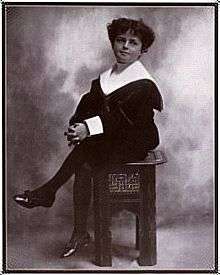
The couple had two children: Robert Winsor, born June 21, 1896; and Marion Elizabeth, born August 22, 1897.[21] McCay was said to be easygoing with the children, and left discipline to their stern mother.[113] Marion felt domineered by her mother and perceived that her brother was her mother's favorite; she was closer to her father and often appeared in public with him.[113] Robert looked up to his father and became an artist himself. He was proud to have served as the model for Little Nemo.[117]
The McCays lived lavishly. McCay disliked driving, so kept a chauffeur who also served as bodyguard, as the editorial cartoons McCay drew for Hearst sometimes attracted threatening letters. Maude made daily trips by limousine to shop in upscale downtown Brooklyn with other well-to-do wives. Maude often complained to her husband, but he refused to discuss matters with her.[118]
McCay's politics are unclear, and it is disputed whether he sympathized with the viewpoints displayed in his editorial cartoons.[119] He was agnostic and believed in reincarnation. He was a lifelong member of the Freemasons, which he may have joined as early as when he was living in Chicago. His father had also been a Freemason, and was buried in 1915 with full Masonic rites,[16] with funerals arranged by his Masonic lodges in both Woodstock, Ontario, and Edmore, Michigan. His mother often visited him in Brooklyn, and attended Little Nemo's Philadelphia premiere. She died in Edmore, Michigan, in 1927.[77]
McCay's brother Arthur was placed in a mental hospital in Traverse City, Michigan on March 7, 1898, where he stayed until his death from bronchopneumonia and arteriosclerosis on June 15, 1946. He never received family visits. McCay never let his children know about his brother, nor did they know about the existence of his sister Mae,[120] who died in 1910.[54]
Legacy
"It is as though the first creature to emerge from the primeval slime was Albert Einstein; and the second was an amoeba, because after McCay's animation it took his followers nearly twenty years to find out how he did it. The two most important people in animation are Winsor McCay and Walt Disney, and I'm not sure which should go first."
Animator Chuck Jones[121]
In 1937, McCay's son Robert attempted to carry on his father's legacy by reviving Little Nemo. Comic book packager Harry "A" Chesler's syndicate announced a Sunday and daily Nemo strip, credited to "Winsor McCay, Jr." Robert also drew a comic book version for Chesler called Nemo in Adventureland starring grown-up versions of Nemo and the Princess. Neither project lasted long.[122] In 1947, Robert and fabric salesman Irving Mendelsohn organized the McCay Feature Syndicate, Inc. to revive the original Nemo strip from McCay's original art, modified to fit the size of modern newspaper pages. This revival also did not last.[123]
McCay's original artwork has been poorly preserved.[124] McCay insisted on having his originals returned to him, and a large collection that survived him was destroyed in a fire in the late 1930s. His wife was unsure how to handle the surviving pieces, so his son took on the responsibility and moved the collection to his own house.[122] The family sold off some of the artwork when they were in need of cash. Responsibility for it passed to Mendelsohn, then later to daughter Marion. By the early twenty-first century, most of McCay's surviving artwork remained in family hands.[125]
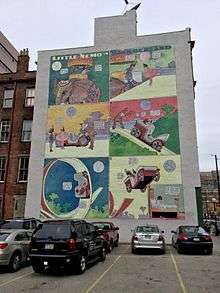
McCay destroyed many of his original cans of film to create more storage space. Of what film he kept, much has not survived, as it was photographed on original 35mm nitrate film, which deteriorates and becomes inflammable in storage. Mendelsohn's son and a friend, both young animators, discovered the film in Mendelsohn's possession in 1947 and rescued what they could. In some cases, such as The Centaurs, only fragments could be saved. A negative and incomplete positive was discovered of Performing Animals, a film of animals playing instruments that may have been intended for McCay's vaudeville act; it was deemed unsalvageable and destroyed.[126]
In 1966, cartoonist Woody Gelman discovered the original artwork for many Little Nemo strips at a cartoon studio where McCay's son Robert had worked. Many of the recovered originals were displayed at the Metropolitan Museum of Art under the direction of curator A. Hyatt Mayor. In 1973, Gelman published a collection of Little Nemo strips in Italy.[127] His collection of McCay originals is preserved at the Billy Ireland Cartoon Library & Museum at Ohio State University.[128]

McCay's work, grounded solidly in his understanding of realistic perspective, presaged the techniques featured in Walt Disney's feature films.[13] Disney paid tribute to McCay in 1955 on an episode of Disneyland. The episode, "The Story of Animated Drawing", gave a history of animation, and dramatized McCay's vaudeville act with Gertie. Robert was invited to the Disney studios as a consultant on the episode, where Disney told him, "Bob, all this should be your father's".[129]
Animator and McCay biographer John Canemaker produced a film in 1974 called Remembering Winsor McCay, narrated by McCay's animation assistant John Fitzsimmons. Canemaker helped coordinate the first retrospective of McCay's films at the third International Animation Film Festival in 1975 in New York, which led to a film show at the Whitney Museum of American Art in winter 1975–76.[129] Canemaker also wrote a biography in 1987 called Winsor McCay: His Life and Art. In 2005, a revised and expanded version of the biography was released, which comics scholar Jeet Heer called "far and away the most scholarly and intelligent biography ever written about an American cartoonist".[124] Animation scholar Paul Wells stated, "McCay's influence on the history of animation cannot be understated".[130] Film critic Richard Eder lamented that as an animation pioneer McCay was not able to reach the potential suggested by his work. Eder compared McCay to the Italian primitives of the early Renaissance, highly skilled "in the limited techniques they could command".[103] Heer wrote that McCay's strength was in his visuals, but that his writing and characters were weak.[124]
Italian filmmaker Federico Fellini read Little Nemo in the children's magazine Il corriere dei piccoli, and the strip was a "powerful influence" on the filmmaker, according to Fellini biographer Peter Bondanella.[131] Comics historian R. C. Harvey has called McCay "the first original genius of the comic strip medium" and in animation. Harvey said that McCay's contemporaries lacked the skill to continue with his innovations, so that they were left for future generations to rediscover and build upon.[39]
McCay's work has inspired cartoonists from Carl Barks[132] to Art Spiegelman.[133] Robert Crumb called McCay a "genius" and one of his favorite cartoonists. Art Spiegelman's 1974 "Real Dream" strip was partially inspired by Rarebit Fiend,[134] and his In the Shadow of No Towers in 2004 appropriated some of McCay's imagery, and included a page of Little Nemo in its appendix.[124] Maurice Sendak's children's book In the Night Kitchen (1970) was an homage to McCay's work,[135] as was Rick Veitch' comic book series Roarin' Rick's Rarebit Fiends (1994–96).[136] Kim Deitch and Simon Deitch's graphic novel The Boulevard of Broken Dreams revolved around a character named Winsor Newton,[lower-alpha 4] based on an aged McCay.[137] Cartoonist Berke Breathed lamented that the conditions of newspaper cartooning had devolved to such a degree since McCay's time that, had he worked later in the century, he would not have been allotted space sufficient for his expansive full-page fantasies.[138]
.jpg)
As Sigmund Freud's The Interpretation of Dreams first appeared in print in 1899, McCay's major dream strips work have invited speculation of a Freudian influence. A comic strip that appeared in Freud's book, "A French Nurse's Dream", strongly resembles the work of McCay in its theme, pacing Art Nouveau style, and closing panel of the dreamer awakening in bed. However, the English translation of Freud's book was not published until 1913.[139]
The Winsor McCay Award was established in 1972 to recognize individuals for lifetime or career contributions in animation, and is presented as part of the Annie Awards.[140] The Hammer Museum in Los Angeles devoted a room to McCay's work as part of the Masters of American Comics exhibit in 2005.[124] In 2014, Taschen published a complete edition covering all spreads of Little Nemo, entitled The Complete Little Nemo.[141]
Work
Style
Virtually from the beginning, McCay innovated with the forms of his chosen media. He varied the size and shape of comic strip panels for dramatic effect, as in the second instalment of Little Nemo (October 22, 1905), where the panels grow to adapt to a growing forest of mushrooms.[39] Few of McCay's contemporaries were so bold with their page layouts. Near-contemporary George Herriman with Krazy Kat was the most notable example, but it was not until a generation later that cartoonists such as Frank King with Gasoline Alley, Hal Foster with Prince Valiant, and Roy Crane with Captain Easy attempted such daring designs on their Sunday pages.[142]
_bottom_half.jpeg)
McCay's detailed hatching[22] mastery of perspective enhanced the illusions in his drawings, particularly in Little Nemo.[13] Fantastic grotesqueries such as what McCay witnessed during his time at the Wonderland and Eden Musee appeared often in McCay's work.[10] McCay was noted for the speed and accuracy with which he could draw; crowds of people would gather around to watch him paint billboards.[143]

Rip, "Un projet téméraire", 1888
McCay had a taste for the ornate. The architecture he drew was inspired by that of carnivals and the 1893 World's Columbian Exposition in Chicago. The detailed illustrations in British illustrated newspapers The Illustrated London News and The Graphic. The Maison Quantin of Paris published a series of illustrated books called Images Enphantines, whose pages bear a striking resemblance to McCay's early Little Nemo strips, both in their graphic sense and their imaginative layouts.[144]
To Canemaker, McCay had an "absolute precision of line"[82] akin to those of Northern Renaissance artist Albrecht Dürer and 19th-century French illustrator Gustave Doré.[145] McCay drew with Higgins black drawing ink, Gillott #290 pens, art gum, a T-square and angle, and an assortment of Venus lead pencils.[33] In his early magazine cartoons McCay often painted in gouache.[146]
McCay used metafictional techniques such as self-referentiality in his work. This was most frequent in Dream of the Rarebit Fiend, where McCay sometimes put himself in the strip, or had characters address the reader. Sometimes characters become aware of the strip itself—a jealous lover tears the very strip apart in which he appears; another character fastens panel borders to his strip when he realizes the artist has forgotten them;[147] and in a Sammy Sneeze episode Sammy's sneeze destroys the panel borders.[148]
In contrast to the high level of skill in the artwork, the dialogue in McCay's speech balloons is crude, sometimes approaching illegibility,[149] and "disfigur[ing] his otherwise flawless work",[138] according to critic R. C. Harvey.[138] This is further highlighted by the level of effort and skill apparent in the title lettering.[150] McCay seemed to show little regard for the dialogue balloons, their content, and their placement in the visual composition. They tended to contain repetitive monologues expressing the increasing distress of the speakers, and showed that McCay's gift was in the visual and not the verbal.[151]
In his comics and animation McCay used stock ethnic stereotypes common in his era.[152] A conscious attempt to offend is not apparent.[153] He depicted blacks as savages, or wishing they could be white.[154] Most prominent were a pair of characters in Little Nemo: the ill-tempered Irishman Flip and the rarely speaking grass-skirted African Little Imp. In the animated Little Nemo, the Anglo-Saxon Nemo is shown drawn in a dignified Art Nouveau style, and controls by magic the more grotesquely caricatured Flip and Imp.[155] Women were few in McCay's work, and were depicted as superficial, jealous, and argumentative; the Princess in Little Nemo never partook in the camaraderie the males shared.[156]
List of comic strips
| Title | Begin date | End date | Notes |
|---|---|---|---|
| A Tale of the Jungle Imps by Felix Fiddle[24] | Jan 11, 1903[24] | Nov 9, 1903[24] |
|
| Mr. Goodenough[28] | Jan 21, 1904[28] | Mar 4, 1904[28] | |
| Sister's Little Sister's Beau[28] | Apr 24, 1904[28] | Apr 24, 1904[28] | |
| Phurious Phinish of Phoolish Philipe's Phunny Phrolics[28] | May 28, 1904[28] | May 28, 1904[28] | |
| Little Sammy Sneeze[28] | Jul 24, 1904[28] | Dec 9, 1906[28] | |
| Dream of the Rarebit Fiend[29] | Sep 10, 1904[29] | Jun 25, 1911[29] | |
| Jan 19, 1913[29] | Aug 3, 1913[29] |
| |
| The Story of Hungry Henrietta[35] | Jan 8, 1905[35] | Jul 16, 1905[35] | |
| A Pilgrim's Progress By Mister Bunion[159] | Jun 26, 1905[160] | May 4, 1909[161] |
|
| Little Nemo in Slumberland[37] | Oct 15, 1905[37] | Jul 23, 1911[37] |
|
| Aug 3, 1924[100] | Dec 26, 1926[100] |
| |
| Poor Jake[52] | 1909[52] | 1911[52] |
|
| In the Land of Wonderful Dreams[37] | Sep 3, 1911[37] | Dec 26, 1914[37] | |
| Rarebit Reveries[162] | c. 1923[163] | c. 1925[163] | |
| Title | Begin date | End date | Notes |
Filmography
| Title | Year | Notes | File |
|---|---|---|---|
| Little Nemo[59] | 1911[59] |
|
.webm.jpg) |
| How a Mosquito Operates | 1912[165] |
|
_How_a_Mosquito_Operates.webm.jpg) |
| Gertie the Dinosaur | 1914[166] | Gertie_the_Dinosaur.webm.jpg) thumbtime=9:48 | |
| The Sinking of the Lusitania | 1918[90] | _The_Sinking_of_the_Lusitania.webm.jpg) | |
| Bug Vaudeville | 1921[167] | .webm.jpg) | |
| The Pet | 1921[93] | _The_Pet.webm.jpg) | |
| The Flying House | 1921[91] | _The_Flying_House.webm.jpg) | |
| The Centaurs | 1921 |
|
.webm.jpg) |
| Gertie on Tour | c. 1918–21[168] |
|
_Gertie_on_Tour.webm.jpg) |
| Flip's Circus | c. 1918–21[168] |
|
_Flip's_Circus.webm.jpg) |
| Performing Animals | unknown |
|
|
| Title | Year | Notes | File |
Notes
- ↑ Upper Canada became the southern portion of the Canadian province of Ontario upon Canadian Confederation in 1867.
- ↑ The Kohl & Middleton Dime Museum was previously called the Vine Street Dime Museum.[14]
- ↑ Keith had partnered with Proctor in 1906.
- ↑ A pun on Winsor & Newton, whose ink brushes are popular with cartoonists.
- ↑
 Wikimedia Commons has a file available for the full strip.
Wikimedia Commons has a file available for the full strip.
References
- 1 2 Haverstock, Vance & Meggitt 2000.
- 1 2 Fodor 2001.
- 1 2 Canemaker 2005, p. 21.
- ↑ Grand Lodge of British Columbia and Yukon 2002.
- 1 2 3 4 5 Canemaker 2005, p. 22.
- ↑ Canemaker 2005, p. 22; Bien 2011, p. 123.
- 1 2 3 Canemaker 2005, p. 46.
- 1 2 3 4 5 Canemaker 2005, p. 23.
- ↑ Canemaker 2005, p. 24.
- 1 2 Canemaker 2005, p. 28.
- ↑ Canemaker 2005, pp. 28–29.
- ↑ Canemaker 2005, p. 30.
- 1 2 3 Canemaker 2005, p. 31.
- 1 2 3 4 Canemaker 2005, p. 38.
- ↑ Canemaker 2005, p. 33.
- 1 2 Canemaker 2005, p. 34.
- ↑ Canemaker 2005, p. 43.
- 1 2 Canemaker 2005, p. 40.
- ↑ Canemaker 2005, pp. 43–44.
- 1 2 3 Canemaker 2005, p. 45.
- 1 2 Canemaker 2005, p. 47.
- 1 2 Canemaker 2005, p. 48.
- ↑ Canemaker 2005, p. 57.
- 1 2 3 4 5 Canemaker 2005, p. 60.
- ↑ Canemaker 2005, p. 64.
- ↑ Canemaker 2005, p. 71.
- ↑ Canemaker 2005, p. 74.
- 1 2 3 4 5 6 7 8 9 10 11 12 13 14 Canemaker 2005, p. 75.
- 1 2 3 4 5 6 7 Canemaker 2005, p. 78.
- ↑ Canemaker 2005, p. 79.
- ↑ Dover editors 1973, p. ix.
- ↑ Canemaker 2005, pp. 125–126.
- 1 2 Canemaker 2005, p. 127.
- 1 2 Canemaker 2005, p. 87.
- 1 2 3 4 Canemaker 2005, p. 92.
- 1 2 Canemaker 2005, p. 94.
- 1 2 3 4 5 6 7 8 9 Canemaker 2005, p. 97.
- ↑ Harvey 1994, p. 21; Hubbard 2012; Sabin 1993, p. 134; Dover editors 1973, p. vii; Canwell 2009, p. 19.
- 1 2 3 4 Harvey 1994, p. 21.
- ↑ Crafton 1993, p. 97.
- ↑ Harvey 1994, p. 22; Canemaker 2005, p. 107.
- ↑ Canemaker 2005, p. 131.
- 1 2 3 Canemaker 2005, p. 132.
- ↑ Stabile & Harrison 2003, p. 3.
- ↑ Canemaker 2005, p. 135.
- ↑ Canemaker 2005, p. 137.
- 1 2 Canemaker 2005, p. 141.
- 1 2 Canemaker 2005, p. 143.
- ↑ Canemaker 2005, p. 148.
- 1 2 Canemaker 2005, p. 149.
- 1 2 Canemaker 2005, p. 151.
- 1 2 3 4 Canemaker 2005, p. 121.
- ↑ Canemaker 2005, pp. 151–153.
- 1 2 3 Canemaker 2005, p. 153.
- ↑ Beckerman 2003, pp. 18–19.
- ↑ Harvey 1994, p. 33.
- ↑ Beckerman 2003; Canemaker 2005, p. 157.
- 1 2 Canemaker 2005, p. 157.
- 1 2 3 4 Canemaker 2005, p. 160.
- ↑ Canemaker 2005, p. 163.
- 1 2 3 4 5 6 Canemaker 2005, p. 164.
- 1 2 Canemaker 2005, p. 168.
- 1 2 Canemaker 2005, p. 167.
- ↑ Berenbaum 2009, p. 138; Telotte 2010, p. 54.
- ↑ Barrier 2003, p. 17; Canemaker 2005, p. 165.
- 1 2 Canemaker 2005, p. 175.
- ↑ Canemaker 2005, p. 176.
- ↑ Canemaker 2005, p. 177.
- 1 2 Canemaker 2005, p. 182.
- ↑ Canemaker 2005, p. 169.
- ↑ Canemaker 2005, p. 171.
- ↑ Sito 2006, p. 36; Canemaker 2005, p. 172.
- ↑ Canemaker 2005, p. 172.
- ↑ Canemaker 2005, p. 174.
- ↑ Canemaker 2005, p. 181.
- 1 2 Heer 2006; Canemaker 2005, p. 181.
- 1 2 Canemaker 2005, p. 185.
- ↑ Canemaker 2005, p. 187.
- ↑ Canemaker 2005, p. 204.
- ↑ Canemaker 2005, p. 205.
- 1 2 Canemaker 2005, p. 207.
- 1 2 Canemaker 2005, p. 209.
- ↑ Canemaker 2005, pp. 182–184.
- ↑ Canemaker 2005, p. 186.
- 1 2 3 Canemaker 2005, p. 212.
- 1 2 3 4 5 Canemaker 2005, p. 193.
- 1 2 Canemaker 2005, p. 188.
- ↑ Kundert-Gibbs & Kundert-Gibbs 2009, p. 46.
- ↑ Canemaker 2005, p. 196.
- 1 2 Canemaker 2005, p. 195.
- 1 2 3 4 5 Canemaker 2005, pp. 197–198.
- ↑ Sito 2006, p. 36.
- 1 2 Canemaker 2005, p. 198.
- ↑ Canemaker 2005, pp. 198, 217.
- ↑ Canemaker 2005, p. 223.
- ↑ Canemaker 2005, p. 216.
- 1 2 3 Canemaker 2005, p. 226.
- ↑ Canemaker 2005, p. 225.
- ↑ Canemaker 2005, p. 228.
- 1 2 3 4 5 Canemaker 2005, p. 229.
- 1 2 Canemaker 2005, p. 235.
- ↑ Canemaker 2005, p. 237.
- 1 2 Canemaker 2005, p. 199.
- ↑ Canemaker 2005, p. 239.
- ↑ Canemaker 2005, pp. 238–239.
- ↑ Canemaker 2005, p. 240.
- ↑ Canemaker 2005, p. 249.
- ↑ Syracuse Herald staff 1934.
- 1 2 3 Canemaker 2005, p. 251.
- ↑ Canemaker 2005, pp. 251–252.
- ↑ Canemaker 2005, pp. 40, 139.
- 1 2 Canemaker 2005, p. 244.
- 1 2 3 4 5 Canemaker 2005, p. 202.
- ↑ Taylor 2007, p. 555.
- ↑ Canemaker 2005, p. 45; Merkl 2007, p. 512.
- ↑ http://www.boston.com/news/globe/ideas/articles/2006/01/08/the_dream_artist/
- ↑ Canemaker 2005, p. 252.
- ↑ Canemaker 2005, pp. 202–203.
- ↑ Shannon 2010, p. 197.
- ↑ Canemaker 2005, pp. 55–56.
- ↑ Canemaker 2005, p. 257.
- 1 2 Canemaker 2005, p. 253.
- ↑ Waugh 1947, pp. 20–21; Canemaker 2005, p. 253.
- 1 2 3 4 5 Heer 2006.
- ↑ Canemaker 2005, pp. 253–254.
- 1 2 Canemaker 2005, p. 254.
- ↑ Jamieson 2010, p. 126.
- ↑ Spencer 2005.
- 1 2 Canemaker 2005, p. 255.
- ↑ Wells 2006, p. 89.
- ↑ Bondanella 2002, p. 10.
- ↑ Ault, Andrae & Gong 2003, p. 91.
- ↑ Jacobowitz 2007, p. 164.
- ↑ Young 2000.
- ↑ Nel 2005, p. 204.
- ↑ Markstein 2007.
- ↑ Gardner 2012, p. 158.
- 1 2 3 Harvey 1994, p. 28.
- ↑ Shannon 2010, pp. 191–193.
- ↑ Dixon 2008.
- ↑ Alexander Braun: Taschen, Cologne 2014, Winsor McCay. The Complete Little Nemo
- ↑ Harvey 1994, pp. 21–22.
- ↑ Taylor 2005, Introduction.
- ↑ Smolderen 2014.
- ↑ Canemaker 2005, pp. 209, 212.
- ↑ Canemaker 2005, p. 55.
- ↑ Bukatman 2012, p. 63.
- ↑ Harvey 1994, p. 25.
- ↑ Gutjahr & Benton 2001, p. 166; Heller 2007.
- ↑ Gutjahr & Benton 2001, p. 166.
- ↑ Taylor 2007, p. 554.
- ↑ Shannon 2010, p. 197; Canemaker 2005, pp. 52–53.
- ↑ Shannon 2010, p. 200.
- ↑ Canemaker 2005, pp. 52–53.
- ↑ Winokur 2012, pp. 58, 63.
- ↑ Canemaker 2005, p. 46–47.
- ↑ Merkl 2007, p. 488.
- ↑ van Opstal 2008.
- 1 2 3 McKinney 2015, p. 1.
- ↑ McKinney 2015, p. 2.
- ↑ McKinney 2015, p. 11.
- 1 2 3 Merkl 2007, p. 466.
- 1 2 Merkl 2007, p. 485.
- ↑ Bukatman 2012, p. 109.
- ↑ Bendazzi 1994, p. 16.
- ↑ Crafton 1993, p. 110; Canemaker 2005, p. 183.
- ↑ Canemaker 2005, p. 197.
- 1 2 Canemaker 2005, p. 194.
Works cited
Books
- Ault, Donald; Andrae, Thomas; Gong, Stephen (2003). "An Interview with Carl Barks: Duckburg's True Founding Father". In Ault, Donald. Carl Barks: Conversations. University Press of Mississippi. pp. 91–108. ISBN 978-1-57806-501-1.
- Barrier, Michael (2003). Hollywood Cartoons: American Animation in Its Golden Age. Oxford University Press. ISBN 978-0-19-516729-0.
- Beckerman, Howard (2003). Animation: The Whole Story. Skyhorse Publishing. ISBN 978-1-58115-301-9.
- Bendazzi, Giannalberto (1994). Cartoons: One Hundred Years of Cinema Animation. Indiana University Press. ISBN 978-0-253-31168-9.
- Berenbaum, May R. (2009). The Earwig's Tail: A Modern Bestiary of Multi-Legged Legends. Harvard University Press. ISBN 978-0-674-03540-9.
- Bien, Laura (2011). Hidden History of Ypsilanti. The History Press. ISBN 978-1-60949-289-2.
-
 Bondanella, Peter (2002). The Films of Federico Fellini. Cambridge University Press. ISBN 978-0-521-57573-7. – via Questia (subscription required)
Bondanella, Peter (2002). The Films of Federico Fellini. Cambridge University Press. ISBN 978-0-521-57573-7. – via Questia (subscription required) - Bukatman, Scott (2012). The Poetics of Slumberland: Animated Spirits and the Animating Spirit. University of California Press. ISBN 978-0-520-95150-1.
- Canemaker, John (2005). Winsor McCay: His Life and Art (Revised ed.). Abrams Books. ISBN 978-0-8109-5941-5.
- Canwell, Bruce (2009). Mullaney, Dean, ed. Bringing Up Father: From Sea to Shining Sea the Cross-Country Tour of 1939–1940. IDW Publishing. ISBN 978-1-60010-508-1.
- Crafton, Donald (1993). Before Mickey: The Animated Film 1898–1928. University of Chicago Press. ISBN 9780226116679.
- Dover editors (1973). Dreams of the Rarebit Fiend. Dover Publications. ISBN 978-0-486-21347-7.
- Gardner, Jared (2012). Projections: Comics and the History of Twenty-First-Century Storytelling. Stanford University Press. ISBN 978-0-8047-8178-7.
- Gutjahr, Paul C.; Benton, Megan L. (2001). Illuminating Letters: Typography and Literary Interpretation. University of Massachusetts Press. ISBN 978-1-55849-288-2.
- Harvey, Robert C. (1994). The Art of the Funnies: An Aesthetic History. University Press of Mississippi. ISBN 978-0-87805-612-5.
- Haverstock, Mary Sayre; Vance, Jeannette Mahoney; Meggitt, Brian L. (2000). "McCay, Winsor Zenic (1869–1934)". Artists in Ohio, 1787-1900: A Biographical Dictionary. Kent State University Press. p. 549. ISBN 978-0-87338-616-6.
- Jacobowitz, Susan (2007). "'Words and Pictures Together": An Interview with Art Spiegelman". In Witek, Joseph. Art Spiegelman: Conversations. University Press of Mississippi. pp. 152–162. ISBN 978-1-934110-12-6.
- Jamieson, Dave (2010). Mint Condition: How Baseball Cards Became an American Obsession. Atlantic Monthly Press. ISBN 978-0-8021-1939-1.
- Kundert-Gibbs, John; Kundert-Gibbs, Kristin (2009). Action!: Acting Lessons for CG Animators. John Wiley & Sons. ISBN 978-0-470-59605-0.
- Merkl, Ulrich (2007). The Complete Dream of the Rarebit Fiend (1904-1913) by Winsor McCay 'Silas' (.doc). Catalog of episodes & text of the book: Ulrich Merkl. ISBN 978-3-00-020751-8. (on included DVD)
- Nel, Philip (2005). Dr. Seuss: American Icon. Continuum. ISBN 978-0-8264-1708-4.
- Sito, Tom (2006). Drawing the Line: The Untold Story of the Animation Unions from Bosko to Bart Simpson. University Press of Kentucky. ISBN 978-0-8131-2407-0.
- Stabile, Carol A.; Harrison, Mark (2003). Prime Time Animation: Television Animation and American Culture. Taylor & Francis. ISBN 978-0-415-28326-7.
- Telotte, J. P. (2010). Animating Space: From Mickey to Wall-E. University Press of Kentucky. ISBN 978-0-8131-2586-2.
- Sabin, Roger (1993). Adult Comics: An Introduction. Routledge. ISBN 978-0-415-04419-6.
- Smolderen, Thierry (2014). The Origins of Comics: From William Hogarth to Winsor McCay. University Press of Mississippi. ISBN 978-1-61703-149-6.
- Taylor, Constance, ed. (2005). Winsor McCay: Early Works. VI. Checker Book Publishing Group. ISBN 978-0-9753808-3-3.
- Taylor, Jeremy (2007). "Some archetypal symbolic aspects of Dream of the Rarebit Fiend". In Merkl, Ulrich. The Complete Dream of the Rarebit Fiend (1904-1913) by Winsor McCay 'Silas' (.doc). Catalog of episodes & text of the book: Ulrich Merkl. pp. 552–561. ISBN 978-3-00-020751-8. (on included DVD)
- Waugh, Coulton (1947). The Comics. University Press of Mississippi. ISBN 978-0-87805-499-2.
- Wells, Paul (2006). The Fundamentals of Animation. AVA Publishing. ISBN 978-2-940373-02-4.
- Winokur, Mark (2012). "Creole Cartoons". In Kessel, Martina; Merziger, Patrick. The Politics of Humour: Laughter, Inclusion, and Exclusion in the Twentieth Century. University of Toronto Press. pp. 52–81. ISBN 978-1-4426-4292-8.
Magazines and journals
- Heer, Jeet (2006). "Little Nemo in Comicsland". Virginia Quarterly Review. University of Virginia. 82 (2): 104–121. ISSN 2154-6932.
- McKinney, Kirsten (July 2015). "The Waking Life of Winsor McCay: Social Commentary in A Pilgrim's Progress by Mr. Bunion". International Journal of Comic Art. 17 (1).
- Shannon, Edward A. (2010). "Something Black in the American Psyche: Formal Innovation and Freudian Imagery in the Comics of Winsor McCay and Robert Crumb". Canadian Review of American Studies. 40 (2): 187–211. doi:10.3138/cras.40.2.187. ISSN 1710-114X.
- Spencer, David R. (2005). "The Cartoon Research Library at Ohio State University". Journalism History. 31 (1).
Newspapers
- Heer, Jeet (2006-01-08). "The Dream Artist". The Boston Globe. Retrieved 2012-06-25.
- Hubbard, Amy (2012-10-15). "Celebrating Little Nemo by Winsor McCay; his 'demons' made him do it". Los Angeles Times. Retrieved 2012-12-15.
- "The Cartoonist Group: Background About Winsor McCay".
- Syracuse Herald staff (1934-07-27). "Winsor M'Cay Early Comic Artist, Dies". Syracuse Herald. p. 12.
Web
- Dixon, Gretchen (2008-07-26). "Winsor McCay Award Recipients Announced at Comic Con, San Diego". Reuters. Retrieved 2013-11-30.
- Fodor, Joe (2001-01-30). "Winsor McCay". Find a Grave. Retrieved 2012-12-18.
- Grand Lodge of British Columbia and Yukon staff (2002-01-26). "Zenas Winsor McCay". Grand Lodge of British Columbia and Yukon. Retrieved 2012-12-10.
- Heller, Steven (2007-11-13). "The Rarebit Fiend Dreams On: An Interview with Ulrich Merkl". AIGA. Retrieved 2012-06-25.
- Markstein, Don (2007). "Dream of the Rarebit Fiend". Don Markstein's Toonopedia. Retrieved 2012-06-25.
- van Opstal, Huib (January 2008). "Dreams and Obsessions on Shelf and Screen". For Inspiration Only. Retrieved 2012-09-04.
- Young, James E. (2000). "Art Spiegelman's Maus and the After-Images of History". The New York Times. Retrieved 2012-07-04.
Further reading
- Bracero, Rocky (2008). Winsor McCay: Illustrator Turned Animator and His Influence on Pixar. Fashion Institute of Technology.
- Braun, Alexander (2014). Winsor McCay. The Complete Little Nemo. Taschen. ISBN 978-3-8365-4511-2.
- Collier, Kevin Scott (2015). Growing Up McKay: The Untold Story of Winsor McCay's Life and Times in Spring Lake, Michigan, 1867 - 1885. Book Patch Publishing. ISBN 978-15-1929-424-1.
- Maltin, Leonard (1987). Of Mice and Magic: A History of American Animated Cartoons; Revised and Updated. Plume Books. ISBN 0-452-25993-2.
- Marschall, Rick (April 1986). "Penmen of the Past: Winsor McCay". Nemo. Fantagraphics Books (18): 34–43.
- McCay, Winsor (1983). Marschall, Richard, ed. "In His Own Words: Winsor McCay on Life, Art, Animation and the Danger of Greasy Foods". Nemo. Fantagraphics Books (3): 34–40.
- "Cartoon Library Acquires McCay Collection" (PDF). University Libraries New Notes. Ohio State University. 2006-06-01.
